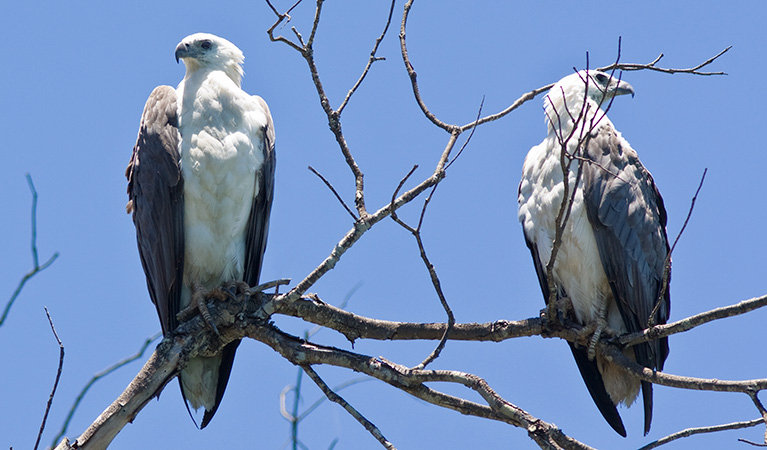Montague Island Lighthouse
Barunguba Montague Island Nature Reserve
Learn more
Learn more about why this park is special
Montague Island Lighthouse is in Barunguba Montague Island Nature Reserve. Here are just some of the reasons why this park is special:
A sacred place

The Yuin people have had a long connection with Barunguba Montague Island, travelling to the island for traditional ceremonies and food, and using it as a men's teaching place. It would have been a dangerous trip - 9km each way by bark canoe. There are many Aboriginal artefacts and middens on the island. Barunguba is the eldest son of Gulaga (Mount Dromedary) and a brother to Najunuka (Little Dromedary). The older brother, Barunguba was allowed out to sea while Najunuka, the younger brother, had to stay close to his mother. To recognise its cultural significance to Yuin people, Barunguba was declared an Aboriginal Place under the National Parks and Wildlife Act 1974 in June 2018.
Colonial heritage

Get in touch with Australia's colonial history - Captain James Cook spotted the island from his tall ship in 1770 but assumed it was part of the mainland. It wasn't until 1790 that the island was officially identified by European Settlers as an island, and named 'Montagu' after the Earl of Halifax George Montagu Dunk, by the master of the convict ship Surprise. The island received visits from several shipwrecked sailors, and during the goldrush seabird eggs were collected from the island to sell to miners.
- Montague Island Lighthouse Montague Island Lighthouse on Barunguba Montague Island is the perfect place to get in touch with history while seeing dramatic views, amazing birds and marine wildlife.
A sanctuary for seabirds, seals and whales

The protected waters of Barunguba Montague Island are a playground for hundreds of seals who make the island their home, all year round. Between September and November you can also see humpback and southern right whales pass the island on their annual migration south. Watch for blowholes and spectacular displays from the island or on a combined whale watching and island tour. With more than 90 bird species seen on the island, and 15 species breeding there, you’ll be reaching for your binoculars – and camera – at every turn. Up to 8,000 penguins live on the island at any one time. Between September and March they are joined by three species of shearwaters, which can produce more than 12,000 chicks per year, and their colonies seem to be growing!
- Barunguba Montague Island 360 experiences Barunguba Montague Island Nature Reserve is a biodiversity hotspot. Explore our 360-degree interactive images to discover some of the threatened and unique animals that live and breed here.
- Barunguba Montague Island walking track This 1.5 km coastal walk around Barunguba Montague Island is short but challenging. It takes you past the historic lighthouse and precious penguin breeding boxes.
- Montague Island Lighthouse Montague Island Lighthouse on Barunguba Montague Island is the perfect place to get in touch with history while seeing dramatic views, amazing birds and marine wildlife.
Plants and animals protected in this park
Animals
-

Australian fur seal (Arctocephalus pusillus doriferus)
The largest fur seal, Australian fur seals are found in isolated rocky outcrops and islands along the NSW coast. They come ashore to form breeding colonies and can often be seen at Barunguba Montague Island Nature Reserve.
-

Humpback whale (Megaptera novaeangliae)
The humpback whale has the longest migratory path of any mammal, travelling over 5000km from its summer feeding grounds in Antarctica to its breeding grounds in the subtropics. Its playful antics, such as body-rolling, breaching and pectoral slapping, are a spectacular sight for whale watchers in NSW national parks.
-

White-bellied sea eagle (Haliaeetus leucogaster)
White-bellied sea eagles can be easily identified by their white tail and dark grey wings. These raptors are often spotted cruising the coastal breezes throughout Australia, and make for some scenic bird watching. Powerful Australian birds of prey, they are known to mate for life, and return each year to the same nest to breed.
Look out for...
Australian fur seal
Arctocephalus pusillus doriferus

The largest fur seal, Australian fur seals are found in isolated rocky outcrops and islands along the NSW coast. They come ashore to form breeding colonies and can often be seen at Barunguba Montague Island Nature Reserve.
